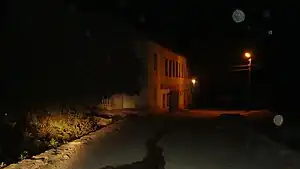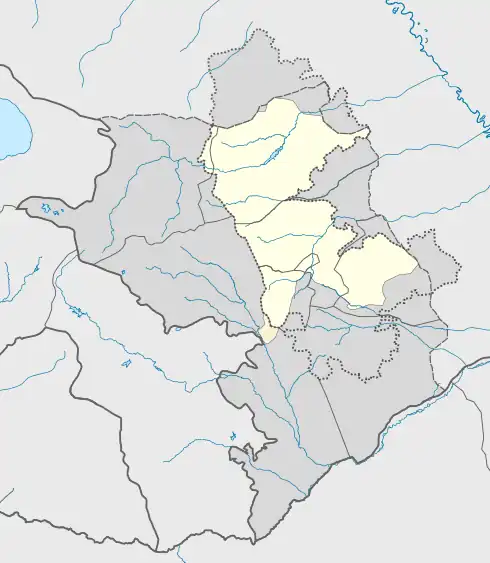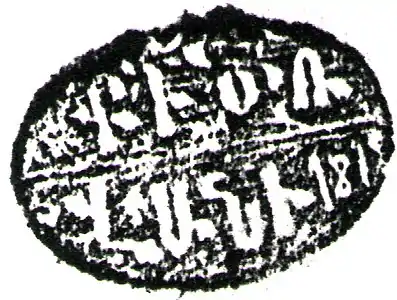Kusapat
Kusapat (Armenian: Կուսապատ; Azerbaijani: Qasapet) or Chiragly (Azerbaijani: Çıraqlı) is a village in the Tartar District of Azerbaijan. Prior to the 2023 Azerbaijani offensive, it was de facto controlled by the Republic of Artsakh as a village in its Martakert Province. The village has an ethnic Armenian-majority population, and also had an Armenian majority in 1989.[2]
Kusapat / Chiragly
Կուսապատ / Çıraqlı | |
|---|---|
| Çıraqlı | |
 | |
 Kusapat / Chiragly  Kusapat / Chiragly | |
| Coordinates: AZ 40°10′36″N 46°43′51″E | |
| Country | |
| • District | Tartar |
| Elevation | 776 m (2,546 ft) |
| Population (2015)[1] | |
| • Total | 259 |
| Time zone | UTC+4 (AZT) |
Etymology
There are different accounts with regard to the origin of the name "Kusapat". In one account the village takes its name from the Armenian word "Kisapat" (Armenian: Կիսապատ) meaning "half wall" or "semi-walled", which has its origin in a story of a devout bricklayer building a church in the village, but after finding out that its inhabitants intended to pay him for his work, he left, leaving the church half-built. In another account, the village takes its name from a convent named "Kuysapat" near the village.[3]
History
Kusapat was founded in the 15th century by Armenian Prince Atabek Hasan-Jalalyan, the fifth son of Prince Jalal III of the Atabekian dynastic branch of the House of Hasan-Jalalyan, when Karabakh was under Persian domination. Atabek won the favor of a Persian sovereign, and was permitted to return and settle in his homeland at a place of his choosing in the territories between the rivers of Tartar and Khachen. With continuous attacks by Lezgins and Tatars and after two military campaigns headed by Agha Mohammad Khan Qajar being conducted in the area, Kusapat and surrounding villages were left deserted by the late 18th century. One of the descendants of Atabek, Melik-Vani Atabekyan (Armenian: Մելիք-Վանի Աթաբեկյան), assisted the Russians in their war against the Persians during the Russo-Persian War (1804–1813) and later rebuilt the village together with families originally from Kusapat. Later, Melik-Vani Atabekyan also founded or restored six other settlements in the area: Mets Shen, Mokhratagh, Maghavuz, Varnkatagh, Vardadzor, and Chankatagh.[3]
During the Soviet period, the village was a part of the Mardakert District of the Nagorno-Karabakh Autonomous Oblast.
Kusapat was badly damaged during the First Nagorno-Karabakh War. On 7 July 1992 the village was captured and destroyed by the Azerbaijani Army. On 16 July 1992, it was recaptured by Artsakh.
Historical heritage sites
Historical heritage sites in and around the village include the church of Surb Astvatsatsin (Armenian: Սուրբ Աստվածածին, lit. 'Holy Mother of God') built in 1269, a 12th/13th-century khachkar, the medieval Martyr's Shrine (Armenian: Նահատակ սրբատեղի, romanized: Nahatak Srbateghi), a medieval cemetery, and the 18th-century Melik-Israyelyan Fortress (Armenian: Մելիք-Իսրայելյանների ամրոց, romanized: Melik-Israyelyanneri Amrots).[1]
Economy and culture
The population is mainly engaged in agriculture and animal husbandry. As of 2015, the village has a municipal building, a secondary school, two shops, and a medical centre.[1]
Demographics
The village had 276 inhabitants in 2005,[4] and 259 inhabitants in 2015.[1] Historically, there has been a Greek presence in the village as well as in the neighboring village of Mehmana.[5]
Gallery
 One of the 11 mills of the Atabekians in Kusapat
One of the 11 mills of the Atabekians in Kusapat Seal of Melik-Vani Atabekyan, Lord of Jraberd
Seal of Melik-Vani Atabekyan, Lord of Jraberd
References
- Hakob Ghahramanyan. "Directory of socio-economic characteristics of NKR administrative-territorial units (2015)".
- Андрей Зубов. "Андрей Зубов. Карабах: Мир и Война". drugoivzgliad.com.
- "1892 Publication Recounts History of 15th Century Armenian Village in Artsakh". Armenian National Committee of America.
- "The Results of the 2005 Census of the Nagorno-Karabakh Republic" (PDF). National Statistic Service of the Republic of Artsakh.
- "Slow Demise of Karabakh Greeks". iwpr.net. 2005-04-27.

